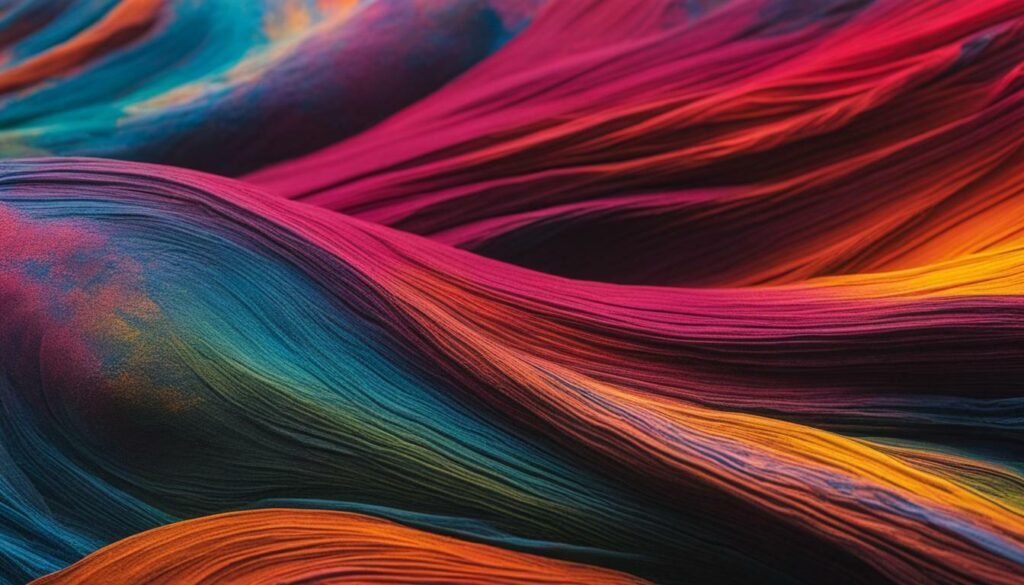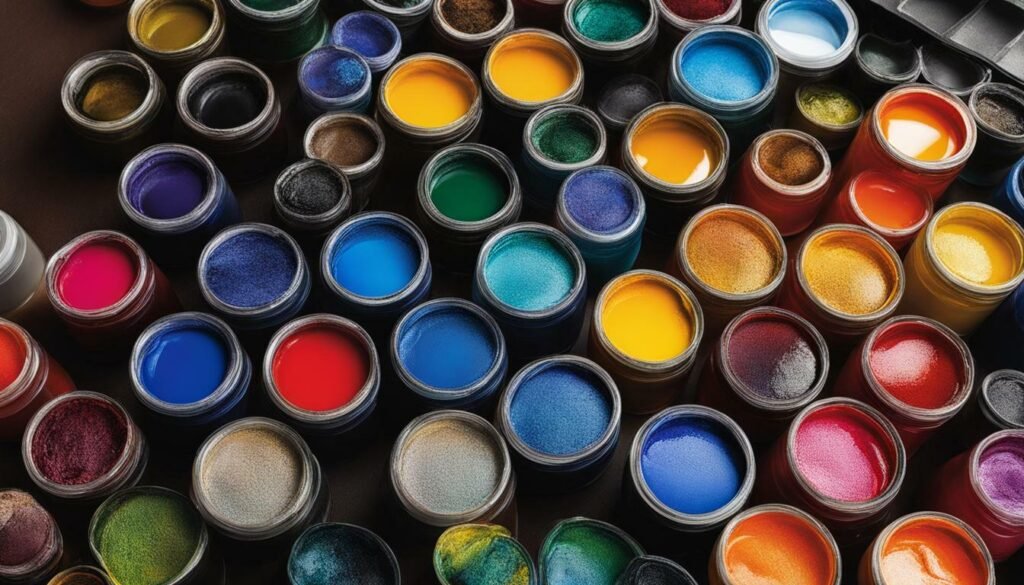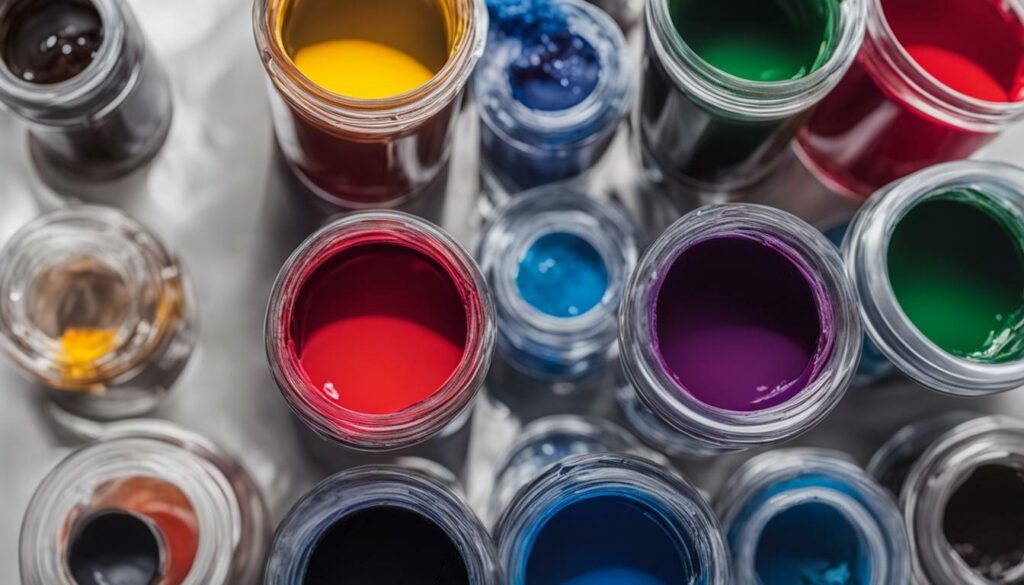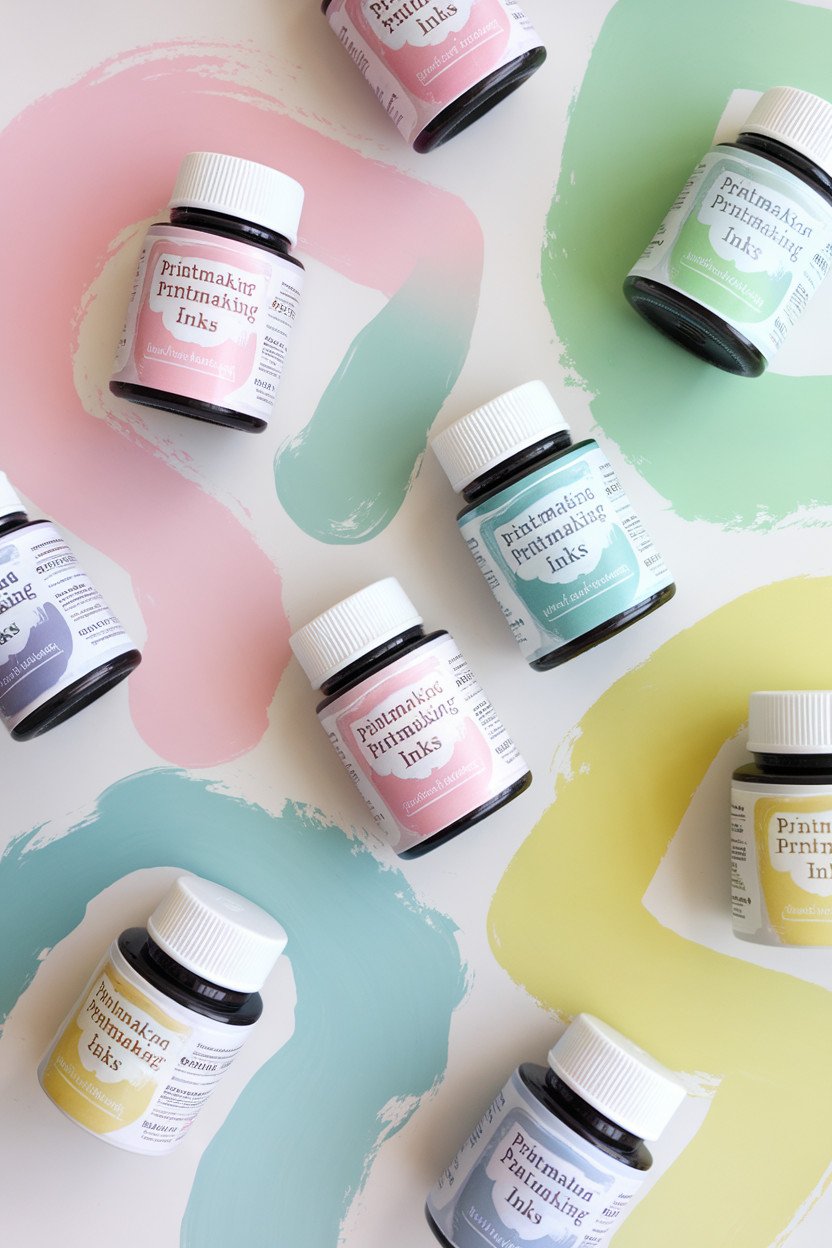Printmaking is a form of art that involves creating multiple images from a single design through various techniques. One of the crucial elements of printmaking is ink selection.
Different types of inks offer unique characteristics and advantages that can greatly influence the outcome of your artwork. In this article, we will explore some of the most commonly used printmaking ink types and their properties.
- Printmaking requires careful consideration of ink selection to achieve desired results.
- Various ink types offer different characteristics that can influence the outcome of your artwork.
- Understanding the properties of different ink types can expand your creative possibilities in printmaking.
- Ink selection should take into account factors such as color intensity, drying time, and compatibility with your chosen technique.
- Proper storage, handling, and maintenance of your printmaking inks are essential for preserving their quality and longevity.
Understanding Oil-Based Inks
If you want your prints to have rich, vibrant colors that last, oil-based inks may be the perfect choice for you. These inks have a slow drying time and a high level of pigment, allowing you to achieve intense color saturation and create prints with incredible depth and clarity.
Oil-based inks are versatile and can be used with various printmaking techniques, including relief printing, intaglio printing, and lithography. Here are some things to keep in mind when working with oil-based inks:
- Use a brayer to apply the ink to the plate or block.
- Wipe away excess ink with a tarlatan cloth or newspaper.
- Print on high-quality paper that can handle the oil-based ink.
- Clean up with a solvent such as mineral spirits or vegetable oil.
When working with oil-based inks, it’s important to note that they can take longer to dry compared to other ink types. This extended drying time can be an advantage, allowing you to work with the ink for longer periods, blend colors, and create subtle gradients. On the other hand, it can also be a challenge, as the ink may smudge or transfer if not handled carefully.
Overall, oil-based inks are a popular choice among printmakers for their color intensity and long-lasting qualities. If you want to create prints with vibrant, eye-catching colors, consider exploring the unique properties and techniques of oil-based inks.

If you’re looking for an environmentally-friendly and easy-to-clean option for your printmaking projects, water-based inks may be the perfect choice.
These inks are made with water as the solvent, as opposed to oil-based inks that use mineral spirits or other chemicals.
Water-based inks offer a range of advantages, including:
- Easy clean up with soap and water, rather than harsh solvents
- Ability to create translucent effects and subtle color variations
- Compatibility with a variety of surfaces, including paper, fabric, and wood
- Less hazardous than solvent-based inks, making them safer to use in a home studio or classroom setting

Whether you’re creating fine art prints or experimenting with graphic design, acrylic inks offer a range of unique properties that can help you achieve stunning results.
- Quick-drying nature: Acrylic inks dry quickly, making them ideal for artists who want to create multilayered prints without having to wait for each layer to dry.
- Compatibility with various surfaces: Acrylic inks can be used on a wide range of surfaces, including paper, canvas, fabric, and more.
- Waterproof and lightfast: Acrylic inks are waterproof when they dry, making them ideal for outdoor and long-lasting prints. They are also lightfast, meaning they won’t fade or discolor over time.
- Wide color range: Acrylic inks come in a range of vibrant colors, including metallic and fluorescent options.

If you’re looking to create bold, high-contrast prints, relief inks are the perfect choice. They are specifically designed for relief printing techniques such as linocut and woodcut. Here’s what you need to know about relief inks:
- Relief inks are generally viscous and have a tacky consistency, which helps them adhere to the printing surface.
- They are available in a variety of colors, with some manufacturers offering custom color options.
- Relief inks can be thinned with oil or solvent to achieve different effects.
- They dry relatively quickly, so it’s important to work efficiently and keep the ink from drying in the block or on the printing surface.
- You can achieve different effects with relief inks depending on how you apply them, such as blending colors or leaving areas uninked for a white-on-black effect.

If you are interested in creating refined prints with intricate details, intaglio inks may be the ideal solution for you.
Intaglio inks are specially formulated to enhance the characteristics of the intaglio printing technique, which involves incising designs into a metal or plastic plate and transferring the ink onto paper using pressure.
Some of the unique properties of intaglio inks include:
- High viscosity to ensure proper ink transfer into the incised lines of the plate
- Slow-drying nature, which allows artists to work at a comfortable pace and achieve fine details
- Rich pigmentation and color intensity, which contribute to achieving beautiful and vivid prints

If you’re looking to create prints on a variety of surfaces, screen printing inks are a great option to consider. These inks are formulated to pass through screens, making them versatile and suitable for an array of applications.
Here’s what you need to know about screen printing inks:
- Screen printing inks come in various types, including water-based, solvent-based, and plastisol.
- Water-based inks are eco-friendly, easy to clean up, and can create unique translucent effects.
- Solvent-based inks offer durability and are ideal for outdoor prints that require resistance to weather conditions.
- Plastisol inks are known for their vibrant colors and are commonly used in printing on textiles such as t-shirts.

Lithographic inks are specially formulated for use in lithography, a printmaking technique in which an image is drawn on a flat surface and transferred onto paper.
These inks are unique in their composition and characteristics, making them essential for achieving high-quality lithographic prints.
Lithographic inks are generally made up of a combination of pigments, oils, and varnishes.
When choosing lithographic inks, it’s important to consider their consistency and viscosity. Lithographic inks should be thick enough to hold their shape when applied to the plate, but thin enough to spread evenly across the surface.
Lithographic inks also come in a range of colors, from basic black to vibrant hues. The ink’s color intensity can be adjusted by altering the ratio of pigment to oil in the ink mixture.

When working with lithographic inks, it’s essential to keep the ink at a consistent temperature and humidity level.
Too much humidity can cause the ink to become tacky, while too little humidity can cause the ink to dry out. It’s also important to store the ink in a cool, dark place to prevent the oil and pigment from separating.
- Consistency and viscosity are essential factors.
- Colors range from basic black to vibrant hues.
- Color intensity can be adjusted by altering the ratio of pigment to oil in the ink mixture.
Discovering Letterpress Inks
One thing to keep in mind when using letterpress inks is that they tend to be thicker than other types of printing inks, so you may need to adjust your printing technique accordingly. As with other printmaking inks, it’s important to experiment with different combinations to achieve your desired effect.
When it comes to cleaning up after using letterpress inks, be sure to use a gentle cleaning solution and avoid harsh solvents that could damage your plates or rollers. With proper care and attention, your letterpress inks can help you create stunning, multi-dimensional prints that stand out from the crowd.
Consider pairing your letterpress inks with a textured paper or incorporating metallic inks for added visual interest. Let your creativity soar as you explore the unique possibilities of letterpress printing.

- Technique: Different printmaking techniques require different ink formulas, so choose an ink that is compatible with your chosen technique.
- Color intensity: The pigmentation of the ink affects the vibrancy of your prints, so consider the level of color intensity you want to achieve.
- Drying time: Ink drying times vary, with some inks taking longer to dry than others. Consider the amount of time you need to work with the ink and the printing process you’re using.
- Surface compatibility: Certain inks may work better on specific surfaces, so consider the type of material you’re printing on.
- Personal preferences: Ultimately, your personal style and preferences will influence your ink selection, so experiment with different inks to find the ones that work best for you.

Choosing the right ink for your printmaking project is essential to achieving the desired results. Here are some tips to help you make an informed decision:
- Consider the printing technique you’re using and choose an ink type that is compatible with it.
- Think about the color intensity and vibrancy you want to achieve in your print.
- Consider the drying time of the ink, as some types dry more quickly than others.
- Take into account the surface you’re printing on and whether the ink is suitable for that surface.
- Consider any personal preferences you may have regarding ink type.

Here are some best practices to keep in mind:
- Store your inks in a cool, dry place, away from direct sunlight and heat sources.
- Keep your inks tightly capped when not in use to prevent air from drying them out.
- Use a spatula or palette knife to transfer ink to your printing surface, rather than dipping directly into the container. This helps keep your ink free of debris and reduces the risk of contamination.
- Clean your tools and surfaces thoroughly after each use to prevent cross-contamination of different ink types.
- If you notice any changes in your ink’s texture, consistency, or odor, discard it and replace it with fresh ink.

When working with printmaking inks, it is crucial to take safety precautionary measures to protect yourself and the environment. Here are some tips to ensure your safety:
- Always wear gloves to protect your skin from exposure to ink or solvents.
- Work in a well-ventilated area or use a respirator to avoid inhaling toxic fumes or vapors.
- Dispose of inks and solvents properly, following the guidelines of your local waste disposal agency.
- Avoid using ink on food or drink containers and utensils as some inks may contain toxic materials.
- Store inks in a cool, dry place, away from direct sunlight or heat sources.
- Keep inks out of reach of children and pets.

If you’re feeling adventurous, mixing different ink types can produce stunning and unexpected effects in your prints. Here are some tips to get you started:
- Choose inks with similar viscosities to ensure they blend well.
- Experiment with different color combinations to create unique hues and tones.
- Consider layering inks to create depth and texture.
- Try mixing opaque and translucent inks for contrast and visual interest.

Issue: Ink not adhering to paper
If you find that the ink is not sticking to the paper, it may be due to a few different issues. Here’s how to address them:
- Ensure that your paper is clean and dry before applying ink.
- Try cleaning your printing plate or surface to remove any leftover ink from previous prints.
- Experiment with different paper types or adjust the pressure of your printing press to find the right balance for your ink.
Issue: Ink bleeding or smudging
Seeing your ink bleed or smudge can be frustrating, but there are a few things you can try to resolve this issue:
- Consider using a different ink type or brand that may be better suited for your printing process.
- Ensure that your paper is thick enough to handle the ink. Thin paper may absorb the ink too quickly, causing it to bleed.
- Allow your prints to dry completely before handling them, or consider using a fixative spray to set the ink.
Issue: Inconsistent ink coverage
If you’re finding that your ink coverage is patchy or uneven, it may be due to one of the following reasons:
- Ensure that your ink is properly mixed and has a consistent texture.
- Experiment with different inking techniques, such as rolling the ink onto your plate in different directions or using a brayer to apply ink more evenly.
- Consider using a different ink type or brand that may offer more consistent coverage for your desired effect.

FAQ
What are the advantages of oil-based inks?
Oil-based inks are known for their rich pigmentation and long drying time, providing vibrant and long-lasting prints.
What are the benefits of using water-based inks?
Water-based inks offer easy clean-up and environmental friendliness, along with versatility and the ability to create translucent effects.
How can acrylic inks enhance creativity in printmaking?
Acrylic inks are quick-drying and compatible with various surfaces, offering artists a wide range of possibilities in terms of techniques and applications.
What makes relief inks ideal for bold prints?
Relief inks are specifically designed for relief printing techniques and are known for creating bold and high-contrast prints, making them perfect for linocut and woodcut.
What are the unique properties of intaglio inks?
Intaglio inks are formulated for intaglio printmaking processes such as etching and engraving, allowing artists to achieve intricate and detailed prints.
What are the characteristics of screen printing inks?
Screen printing inks are designed to pass through screens onto various surfaces, making them suitable for a wide range of applications.
How do lithographic inks contribute to precise prints?
Lithographic inks are specifically formulated for lithography, a printmaking technique that involves a flat surface, resulting in stunning and precise prints.
What makes letterpress inks unique?
Letterpress inks are specifically designed for letterpress printing, known for its distinctive debossed effect, creating tactile and visually appealing prints.
What are the properties of etching inks?
Etching inks are formulated for etching processes, which involve incising designs onto a plate, allowing artists to achieve finely-detailed and textured prints.
How can I select the right ink for my printmaking project?
When choosing the right ink, consider factors such as color intensity, drying time, compatibility with your chosen technique, and personal preferences. Explore tips and guidelines to make an informed decision.
How can I experiment with ink combinations in printmaking?
Mixing different printmaking inks can yield unique effects and expand your creative possibilities. Explore tips and techniques for experimenting with ink combinations to create visually captivating prints.
What can I do to troubleshoot common ink issues in printmaking?
Addressing common ink problems can help you overcome challenges and achieve desired results in your printmaking process. Learn about common issues and effective solutions to resolve them.
Any final thoughts on printmaking ink types?
Embrace the diversity and versatility of printmaking inks as you continue your creative journey. Consider how different ink types can enhance your artistic expression and explore the wealth of options available.
